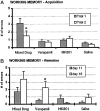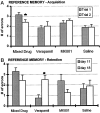Role of voltage-dependent calcium channel long-term potentiation (LTP) and NMDA LTP in spatial memory
- PMID: 11125005
- PMCID: PMC6773014
- DOI: 10.1523/JNEUROSCI.20-24-09272.2000
Role of voltage-dependent calcium channel long-term potentiation (LTP) and NMDA LTP in spatial memory
Abstract
This experiment explores the role of two forms of long-term potentiation (LTP) in behavioral memory. NMDA and/or voltage-dependent calcium channels (VDCCs) were antagonized pharmacologically at levels that block nmdaLTP and vdccLTP, respectively, in rats learning an eight-arm radial maze task. Animals were trained twice a day for 11 d under the systemic influence of MK-801, verapamil, both drugs, or saline. During acquisition, the mixed drug group displayed significantly more working memory errors and reference memory errors than all other groups. The mixed drug group was markedly impaired on the first daily trial but improved dramatically on their second daily trial. After a 7 d delay, saline and MK-801 animals maintained their predelay level of performance. The performance of the verapamil groups declined significantly over the delay. These results demonstrate that: (1) vdccLTP is necessary for the retention of information over a 7 d period, (2) the blockade of both forms of LTP prevents the retention of information over a 21 hr period, and (3) blockade of both forms of LTP does not prevent the storing of information over a short period of time (3 hr).
Figures





References
-
- Bading H, Ginty DD, Greenberg ME. Regulation of gene expression in hippocampal neurons by distinct calcium signaling pathways. Science. 1993;260:181–186. - PubMed
-
- Bliss TV, Collingridge GL. A synaptic model of memory: long-term potentiation in the hippocampus. Nature. 1993;361:31–39. - PubMed
-
- Caramanos Z, Shapiro ML. Spatial memory and N-methyl-d-aspartate receptor antagonists APV and MK-801: memory impairments depend on familiarity with the environment, drug dose, and training duration. Behav Neurosci. 1994;108:30–43. - PubMed
-
- Cavus I, Teyler TJ. Two forms of long-term potentiation in area CA1 activate different signal transduction cascades. J Neurophysiol. 1996;76:3038–3047. - PubMed
-
- Fox K, Daw NW. Do NMDA receptors have critical function in visual cortical plasticity? Trends Neurosci. 1993;16:116–122. - PubMed
Publication types
MeSH terms
Substances
Grants and funding
LinkOut - more resources
Full Text Sources
Medical
